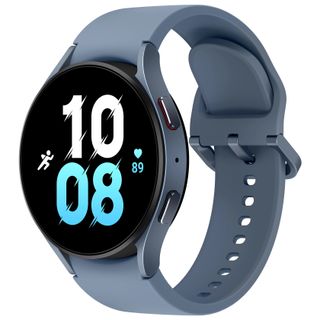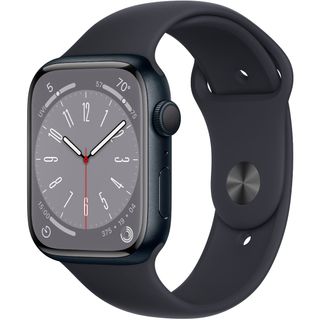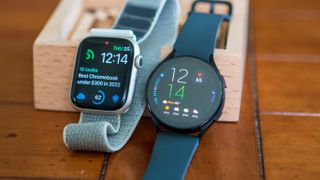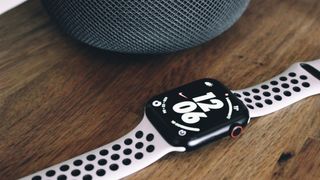Samsung Galaxy Watch 5 vs. Apple Watch Series 8
Choosing between iOS or Android for your next phone? Which smartwatch you prefer may be a major factor in your choice.

The Galaxy Watch 5 is the best Android watch available, especially for Galaxy phone owners. It's extremely durable, with a redesign that gives you more accurate sensor readings than the last generation, and the Wear OS 3.5 update makes it a pleasure to use. It has a wide range of health data paired with decent fitness tools.
For
- Military-grade protection
- Superior battery life to Apple
- Great Wear OS 3.5 software
- BIA sensor
- Fast USB-C charging
Against
- Much thicker design
- Weaker battery than advertised
- Android-only/ some Samsung exclusives
- Temperature sensor not active yet

The Series 8 proves that even Apple's most boring releases still have plenty to offer. It looks and performs near-identically to the Series 7, but its stylish squircle look remains iconic and it has new perks like crash detection and a temperature sensor to keep things fresh. It still hasn't solved the issue of its paltry battery life, unfortunately.
For
- Attractive thin-bezel, 1,000-nit display
- Fluid performance
- Plenty of size, material, & band options
- Crash/fall detection and emergency SOS
- Light, thin design
Against
- iOS-only
- Pricey
- Less than one-day battery life
For years, Samsung was the only smartwatch brand that could offer proper competition to the Apple Watch's runaway success. With its partnership with Google, Samsung took a further leap forward with the Galaxy Watch 4 and Wear OS 3, though this meant its watches could no longer work with iPhones. The same applies this year, which makes the Galaxy Watch 5 vs. Apple Watch Series 8 comparison more of an academic exercise since you can only buy one or the other for your phone — unless you're considering switching to iOS or Android just to get one.
Aside from bragging rights, the bigger importance of this comparison is seeing how these two mobile behemoths are advancing the lifestyle smartwatch market since other Android watch and fitness watch brands will likely follow in their footsteps. On that note, here's how these two watches compare in quality, features, and style.
Samsung Galaxy Watch 5 vs. Apple Watch Series 8: Design and display
Why you can trust Android Central

As always, the Apple Watch Series 8 kept its squircle look that some consider stylish and others stale. Practically identical to the Series 7, it has extremely narrow bezels that enable the watch's pixel-packed display to fit plenty of information on the screen.
The Samsung Galaxy Watch 5 has a distinctive flat-display look that isn't quite as stylish as the Pixel Watch but does have its fans. It has a much more noticeable bezel, but Samsung uses it as a capacitive touch bezel, meaning you swipe your finger around the edge to scroll through Wear OS menus. Our reviewer called the feature "pointless," but others enjoy the option to speed through options quickly instead of swiping repeatedly.
For comparison, the Apple Watch Series 8 has its classic Digital Crown and side button. Our colleagues at iMore noted that the crown offers "tactile scrolling that makes quick navigation a breeze," with more exact results than Samsung's touch bezel can offer. That's especially true during workouts when your fingertips are too sweaty for dainty swipes; on the other hand, the crown may protrude into your wrist during certain gym exercises.
Both watches have some solid protection to make sure your investment isn't damaged too easily. Samsung uses Sapphire Glass, while Apple Watches have custom crack-resistant crystal. And both have IP6X dust protection and are water resistant to 50 meters. The upside to the Galaxy Watch 5 is its MIL-STD-810H protection from falls and environmental damage; it's not quite as rugged as the Galaxy Watch 5 Pro, but it does beat the Apple Watch here.
The Galaxy Watch 5 has just 4 more pixels per inch and the same 1,000 nits as the Apple Watch Series 8, so it's essentially the same visual experience.

Each watch has two size options: the Apple Watch Series 8 comes in 41mm and 45mm varieties, while the Galaxy Watch 5 comes in 40mm and 44mm variants. Although the Series 8 weighs more in both sizes, you do get larger display sizes; and your final experience will depend on which watch band you choose. Most of the best Galaxy Watch 5 bands are on the heavier side, while the standard Apple Watch Solo Loop is especially light.
Samsung misleadingly claims its watches are less than 10mm thick in its marketing. In fact, they're more than 13mm thick when you take the sensors into account, making them protrude much further from your wrist than the 10.7-inch Series 8. Samsung redesigned the Galaxy Watch 5 so its sensors sit flush against your wrist, which supposedly gives you more accurate health results than the Galaxy Watch 4 last year.
Samsung Galaxy Watch 5 vs. Apple Watch Series 8: Hardware and battery life
| Header Cell - Column 0 | Samsung Galaxy Watch 5 | Apple Watch Series 8 |
|---|---|---|
| Display | 1.19-inch (396x396, 330ppi), 1.36-inch (450x450, 330ppi) | 1.6- (352x430, 326ppi) or 1.8-inch (396x484, 326ppi) Retina LTPO OLED |
| Brightness | Up to 1,000 nits | Up to 1,000 nits |
| Material | Aluminum | Aluminum or stainless steel |
| Bands | Two-tone Sport, Global Goals, Fabric, Extreme Sport, Ridge-Sport, Hybrid Fabric, Hybrid Leather, Sport | Solo Loop, Sport Band, Sport Loop, Nylon, Leather, Stainless Steel |
| Navigation | Touchscreen, two buttons, digital bezel | Touchscreen, one crown, one button |
| Processor | Samsung Exynos W920 w/ 1.5GB | S8 SiP with 64-bit dual-core processor |
| Storage | 16GB | 32GB |
| Battery | 284mAh / 410mAh; Up to 50 hours | 282mAh or 308mAh; Up to 18 hours |
| Wireless charging | Yes (proprietary cable) | Yes (proprietary cable) |
| Sensors | Accelerometer, Gyro, Barometer, Ambient Light, Compass, Optical Heart Rate Sensor (8pd), Electrical Heart Sensor (ECG), BIA, Continuous SpO2, Skin Temperature Sensor | Accelerometer, ambient light, barometer/altimeter, compass, ECG, gyroscope, heart rate monitor, pulse oximeter, thermometer |
| Connectivity | LTE (optional), GPS, GLONASS, GALILEO, BeiDou, Bluetooth 5.2, Wi-Fi, NFC | LTE (optional), GPS, GLONASS, GALILEO, BeiDou, QZSS, Bluetooth 5.3, Wi-Fi, NFC, Ultra wideband |
| Compatibility | Android (Google Assistant or Bixby) | iOS (Siri) |
| Protection | 5ATM, IP68, MIL-STD-810H, Sapphire Glass | IP6X, WR50, crack-resistant crystal |
| Size | 40.4 x 39.3 x ~13mm / 44.4 x 43.3 x ~13mm | 41 x 35 x 10.7mm; 45 x 38 x 10.7mm |
| Weight (without band) | 29g / 32.8 grams | 31.9g or 38.8g (aluminum) |
The Exynos W920 and Apple S8 are the same chips found in last year's watches (the Apple S7 and S8 have no obvious differences), so there's no reason to upgrade based on performance in either case. This also isn't a problem in either case, since both have the most consistent performance for demanding watch apps of any brands out there.
In terms of what's beneath the hood, both the Galaxy Watch 5 and Series 8 have an ambient light sensor, accelerometer, barometer/altimeter, electrical heart sensor (ECG), gyroscope, optical heart rate sensor (HRM), and pulse oximeter (SpO2). They also both technically have a skin temperature sensor, but the Galaxy Watch 5 temperature sensor remains inactive months after launch, while Apple uses its skin-sensing tech to detect your body's health and ovulation patterns while you sleep.
The one area where Samsung comes on top is its BioActive Sensor, which performs several tasks like measuring your heart rate, blood oxygen, and body composition all at once instead of with multiple sensors.
Specifically, the Galaxy Watch 5 has a Bioelectrical Impedance Analysis (or BIA) sensor that detects your skeletal muscle, basal metabolic rate, and body water/ fat percentage. Unlike the continuous HRM and SpO2 tracking, you will have to take a body composition measurement manually. Having this information on hand could be useful to detect how your workouts are improving your overall health, or it could be demoralizing for people who struggle with self-confidence or negative body image.
Lastly, these watches mostly have the same satellite tracking and connectivity tools. with minor differences. You get every GNSS system like GPS and GLONASS, but no multi-GNSS or dual-frequency tools like you get on the Apple Watch Ultra or some fitness watches. The Apple Watch Series 8 connects at a slightly higher Bluetooth standard (5.3 vs. 5.2), which can be slightly more energy-efficient, and it's also the only model with Ultra Wideband, so it's easier for your phone to find the Watch if it falls somewhere hidden. Otherwise, they both support wi-fi connectivity and NFC tap-to-pay.

Once again, the Apple Watch Series 8 falls short in terms of battery life, maintaining an 18-hour average, which our iMore colleague Stephen Warwick called, "not bad, but annoying." This average works fine if you only wear it during the day since you can charge it overnight; but to take advantage of sleep tracking means your battery will lose about 33-50% of its power by the time you get out of bed, which "leaves users with the difficulty of judging when to charge it." If Apple could just hit 24 hours, Warwick says, that would make a significant difference.
As for the Galaxy Watch 5, it certainly wins the battery battle on paper, since Samsung claims it can hit about 40-50 hours thanks to a slightly larger battery than in the Galaxy Watch 4. In practice, however, our reviewer found it usually lasted about 24 hours with active use.
Your mileage will vary depending on how often you wake the display and use apps, but suffice it to say the Galaxy Watch 5 is an all-day watch that hits what the Apple Watch Series 8 should. It's simply not a two-day watch like Samsung suggests. You'll need the Galaxy Watch 5 Pro for an actual multi-day watch.
Samsung Galaxy Watch 5 vs. Apple Watch Series 8: Software

Comparing Wear OS 3 to watchOS 9 is about as difficult and in-depth as comparing iOS to Android, so we're not going to make the full comparison here.
Both operating software have similar tools that link up to their respective mobile apps on Android and iOS, where you can control settings and customize apps and appearances. Many app developers create watch apps for both Wear OS and watchOS, so your favorite app either will or won't get wearable support regardless of which ecosystem you choose.
One of the main benefits of choosing an Apple or Samsung watch is the frequent, speedy, and long-lasting software support. The Galaxy Watch 5 will get a confirmed four years of software updates, while the Apple Watch series typically gets four watchOS updates and about 4-5 years of security updates.
Samsung may not offer a new numbered Wear OS release every year — that's up to Google — but the Watch 5 will at least get proper support faster than any other Wear OS watch.

Both watches have their respective free fitness and health tracking apps — Samsung Health and Apple Health — as well as daily goals for steps and activity that you're encouraged to complete by closing your rings. You can check your past workouts and see long-term health trends, including possible irregular heartbeats, sleep efficacy, and more.
While Samsung used to be more of a fitness leader with its Active watches, it arguably slacked off on adding new fitness tech in recent years, while Apple made fitness far more of a focus with watchOS 9 to coincide with the Ultra's release. But the Series 8 got the same software, so you get custom workouts that have you hit the right pace, heart rate zone, effort, or cadence; Apple Fitness+ at-home workouts (if you're willing to pay for them); and other new perks like calculated running power and a triathlon mode. Plus, a new feature that lets you race against past routes is coming in 2022.
Samsung Galaxy Watch 5 vs. Apple Watch Series 8: Which should you buy?
The Samsung Galaxy Watch 5 costs $280/$310 at full price, while the Apple Watch Series 8 costs $400/$430. Plus, the cellular upgrade costs $100 for an Apple Watch while just $30 more for the Galaxy Watch 5. If you consider these two watches on par with one another in quality, it's fair to say that Samsung's watch is the better bargain.
For iOS users, they don't have much of a choice, since there aren't any other lifestyle watches that sync so well with an iPhone 14 Pro or any other iPhone. Your only other choice would be to go all-in on fitness instead. We have a breakdown of the Fitbit Versa 2 vs. Series 8, or the Series 8 against the Versa 4 if you want something closer in price to the Galaxy Watch 5.
Or, you could look into the Fossil Gen 6 Wellness Edition, a Wear OS 3 watch that actually works with iOS and competes well against the Galaxy Watch 5.
Android phone owners have more options depending on what they're looking for. If they want Wear OS 3 with a more attractive form factor, the Google Pixel Watch matches the GW5 in several key areas. And otherwise, you may want to consider how the Galaxy Watch 5 Pro contends with the cheaper Galaxy Watch 5.

The Galaxy Watch 5 can handle falls and environmental dangers, has a comprehensive suite of health sensors, and is much more affordable than you'd expect, especially the 4G/ LTE version. It has years of Wear OS support left, and it gives you full access to Google apps and the Play Store.

Little has changed between the Series 7 and Series 8, but the Apple Watch lineup doesn't need to do much when it has a monopoly of quality for iPhone users. Its latest software makes it a solid choice for casual athletes who want something stylish to wear outside of workouts.
Be an expert in 5 minutes
Get the latest news from Android Central, your trusted companion in the world of Android

Michael is Android Central's resident expert on fitness tech and wearables, with an enthusiast's love of VR tech on the side. After years freelancing for Techradar, Wareable, Windows Central, Digital Trends, and other sites on a variety of tech topics, AC has given him the chance to really dive into the topics he's passionate about. He's also a semi-reformed Apple-to-Android user who loves D&D, Star Wars, and Lord of the Rings.
For wearables, Michael has tested dozens of smartwatches from Garmin, Fitbit, Samsung, Apple, COROS, Polar, Amazfit, and other brands, and will always focus on recommending the best product over the best brand. He's also completed marathons like NYC, SF, Marine Corps, Big Sur, and California International — though he's still trying to break that 4-hour barrier.
